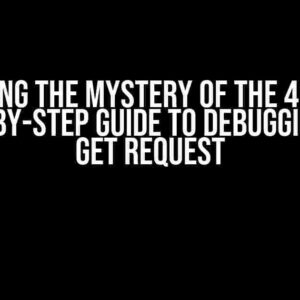Are you tired of being limited by the command line interface on your Raspberry Pi? Do you want to automate tasks and execute commands programmatically using Java? Look no further! In this article, we’ll show you how to execute commands on Raspberry Pi using Java, and unlock the full potential of your mini-computer.
Why Use Java on Raspberry Pi?
Java is a popular programming language that’s widely used in various applications, from Android apps to enterprise software. On Raspberry Pi, Java provides a powerful way to automate tasks, interact with hardware components, and create custom applications. Here are some reasons why you should use Java on Raspberry Pi:
- Platform independence: Java programs can run on any platform that supports Java, including Raspberry Pi.
- Object-oriented programming: Java’s OOP paradigm makes it easy to write reusable and modular code.
- Huge community: Java has a massive community of developers, which means there are plenty of resources available online.
- Hardware interaction: Java allows you to interact with Raspberry Pi’s hardware components, such as GPIO pins, cameras, and sensors.
Setting Up Your Raspberry Pi for Java Development
Before you start executing commands using Java, you need to set up your Raspberry Pi for Java development. Here’s a step-by-step guide to get you started:
- Install Raspbian OS on your Raspberry Pi. You can download the latest version from the official Raspberry Pi website.
- Install Oracle JDK on your Raspberry Pi. You can download the JDK from the Oracle website and follow the installation instructions.
- Install a Java IDE (Integrated Development Environment) such as NetBeans or Eclipse. This will provide you with a graphical interface to write, compile, and run your Java programs.
- Install the Raspberry Pi’s Java library, which provides a set of APIs to interact with the board’s hardware components.
Executing Commands using Java
Now that you have your Raspberry Pi set up for Java development, let’s dive into executing commands using Java. There are two ways to execute commands on Raspberry Pi using Java:
Method 1: Using the Runtime Class
The Runtime class in Java provides a way to execute system-level commands using the `exec()` method. Here’s an example:
import java.io.IOException;
public class ExecuteCommand {
public static void main(String[] args) {
try {
Runtime runtime = Runtime.getRuntime();
Process process = runtime.exec("ls -l");
process.waitFor();
} catch (IOException e) {
System.out.println("Error executing command: " + e.getMessage());
}
}
}In this example, the `exec()` method is used to execute the `ls -l` command, which lists the files in the current directory. The `waitFor()` method is used to wait for the process to complete.
Method 2: Using the ProcessBuilder Class
The ProcessBuilder class provides a more flexible way to execute commands on Raspberry Pi using Java. Here’s an example:
import java.io.IOException;
public class ExecuteCommand {
public static void main(String[] args) {
try {
ProcessBuilder processBuilder = new ProcessBuilder("ls", "-l");
processBuilder.directory(new File("/home/pi"));
Process process = processBuilder.start();
process.waitFor();
} catch (IOException e) {
System.out.println("Error executing command: " + e.getMessage());
}
}
}In this example, the ProcessBuilder class is used to execute the `ls` command with the `-l` option in the `/home/pi` directory. The `start()` method is used to start the process, and the `waitFor()` method is used to wait for the process to complete.
Executing Shell Scripts using Java
Shell scripts are a powerful way to automate tasks on your Raspberry Pi. You can execute shell scripts using Java by using the `Runtime` class or the `ProcessBuilder` class. Here’s an example:
import java.io.IOException;
public class ExecuteScript {
public static void main(String[] args) {
try {
Runtime runtime = Runtime.getRuntime();
Process process = runtime.exec("sh /home/pi/myscript.sh");
process.waitFor();
} catch (IOException e) {
System.out.println("Error executing script: " + e.getMessage());
}
}
}In this example, the `exec()` method is used to execute the shell script `myscript.sh` located in the `/home/pi` directory.
Common Errors and Solutions
When executing commands on Raspberry Pi using Java, you may encounter some common errors. Here are some solutions to common errors:
| Error | Solution |
|---|---|
| Command not found | Make sure the command is installed and in the system’s PATH. |
| Permission denied | Run the Java program as root or use the `sudo` command to execute the command with elevated privileges. |
| IO Exception | Check the command’s syntax and make sure it’s correct. |
Conclusion
In this article, we’ve shown you how to execute commands on Raspberry Pi using Java. We’ve covered the basics of setting up your Raspberry Pi for Java development, executing commands using the `Runtime` class and the `ProcessBuilder` class, and executing shell scripts using Java. With this knowledge, you can automate tasks, interact with hardware components, and create custom applications on your Raspberry Pi.
Remember to follow best practices when executing commands on your Raspberry Pi, and always test your code before deploying it to production. Happy coding!
Frequently Asked Question
Get ready to unleash the power of Raspberry Pi with Java! Here are some frequently asked questions about executing commands on Raspberry Pi using Java.
Q: How can I execute Linux commands on Raspberry Pi using Java?
You can use the Runtime class in Java to execute Linux commands on Raspberry Pi. The Runtime.getRuntime().exec() method allows you to execute a command as if you were in the terminal. For example, to list the files in a directory, you can use the command “ls -l” and execute it using Java like this: Runtime.getRuntime().exec(“ls -l”);
Q: Can I use Java to control the GPIO pins on Raspberry Pi?
Yes, you can! You can use a Java library like Pi4J to control the GPIO pins on Raspberry Pi. Pi4J provides a Java API to access the GPIO pins, allowing you to read and write digital signals, control motors, and interact with other devices connected to the GPIO pins.
Q: How can I run a Java program on startup on Raspberry Pi?
To run a Java program on startup on Raspberry Pi, you can add it to the rc.local file. This file is executed during the boot process, and you can add your Java program to it by adding a line like this: java -jar /path/to/your/program.jar. Make sure to make the script executable by running the command chmod +x /etc/rc.local.
Q: Can I use Java to interact with the Raspberry Pi camera module?
Yes, you can! You can use a Java library like JavaCV to interact with the Raspberry Pi camera module. JavaCV provides a Java API to access the camera, allowing you to capture images, record video, and more. You can also use other libraries like OpenCV to process the images and video captured by the camera module.
Q: Are there any Java IDEs that support Raspberry Pi development?
Yes, there are several Java IDEs that support Raspberry Pi development, including NetBeans, Eclipse, and IntelliJ IDEA. These IDEs provide tools and plugins to help you develop, compile, and deploy your Java programs on Raspberry Pi. You can also use remote debugging to debug your programs running on Raspberry Pi from your IDE.








